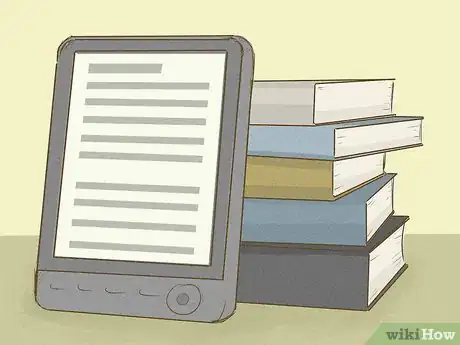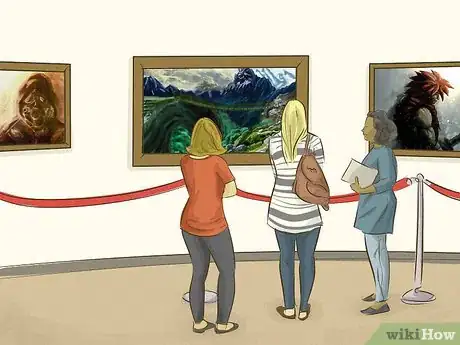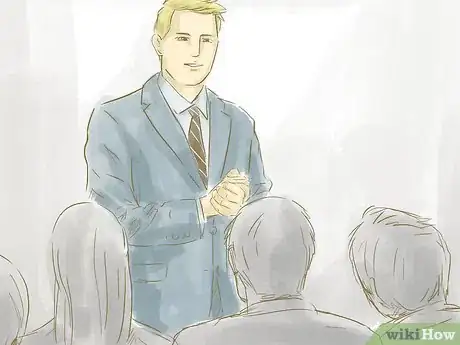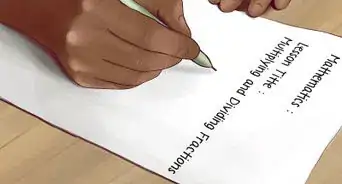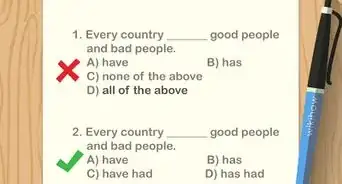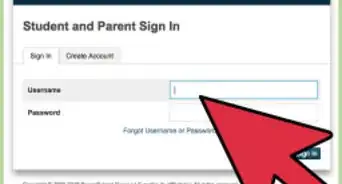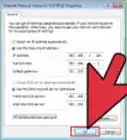This article was co-authored by Jai Flicker. Jai Flicker is an Academic Tutor and the CEO and Founder of Lifeworks Learning Center, a San Francisco Bay Area-based business focused on providing tutoring, parental support, test preparation, college essay writing help, and psychoeducational evaluations to help students transform their attitude toward learning. Jai has over 20 years of experience in the education management industry. He holds a BA in Philosophy from the University of California, San Diego.
There are 9 references cited in this article, which can be found at the bottom of the page.
wikiHow marks an article as reader-approved once it receives enough positive feedback. In this case, several readers have written to tell us that this article was helpful to them, earning it our reader-approved status.
This article has been viewed 47,953 times.
Teachers have many jobs. Two of the most important duties are to educate and encourage. The best teachers usually have one thing in common. Students often say that their best teachers were ones who inspired them. There are several ways to inspire your students. You can find lots of methods to make your classroom more exciting. You can also motivate your students to do their best. Finally, you can help your students be inspired by awesome role models--including yourself!
Steps
Making Your Students Excited
-
1Bring energy to the classroom. A classroom that feels tired probably won't be very inspiring. Take action to make sure that your classroom pulses with energy. Start by pumping up your own enthusiasm. [1]
- Try not to come to class tired. Get up early in the morning so that you are fully awake by class time.
- If your students seem lethargic, try having them get up and move around. Even a quick stretch can wake people up.
-
2Incorporate games. Students might feel more inspiration if they are having fun. Try organizing your lesson around a game. You can adapt this strategy for any age level.[2]
- For elementary school kids, you could adapt the common game Simon Says. Students only get to move a step forward if they can correctly answer the math question, for instance.
- Try a version of Jeopardy for high school or college students. This quiz game is a great way to review for exams.
- Don't feel like everything has to be a game. They can be used every once in a while to insert some energy into your classroom.
Advertisement -
3Get more students involved. Each class is bound to have a few students who are reluctant to participate. However, it is important to make each student feel actively involved in the lesson. Try to get most (if not all) students to participate in activities.[3]
- Some students may not like participating in group discussions. You might need to get creative to make it more appealing.
- Try a lightening round. Set a time limit (maybe 30 seconds) on each question. Make it seem fun and exciting to shout out the correct answer.
- Two ways to get students more involved are group work and having them prepare something individually to share with the class.[4]
-
4Use new technology. Technology can be a great way to bring inspiration into your classroom. There are a number of tools you can use to get your students excited about whatever subject you're teaching. Have fun trying new items together! [5]
- Many schools provide iPads or tablets for student use. Download some fun math games for your students to play.
- If you teach a college course, have your history students create entries for educational apps such as Clio.[6]
-
5Go on field trips. Try to energize your students by taking them out and about. Field trips are an excellent way to inspire and wow your class. Just make sure to tailor the trip to fit the needs of your students.
- Try a children's museum for young kids. For example, the Museum of Science and Industry in Chicago offers an entire wing of exhibits geared towards children.
- If you teach high school or college students, try a walking tour. The Freedom Trail in Boston is a great option if you teach in that area.
Motivating Your Students
-
1Consider intrinsic motivations. Motivating is a big part of inspiring students. If they aren't motivated to learn, there's probably not a lot you can do to inspire them. Take some time to consider student motivations. First, think about intrinsic motivations.[7]
- Intrinsic motivations are basically internal. They are personal to each student.
- For example, intrinsic motivations might include a passion for the subject, or a desire to challenge themselves by mastering a skill.
- In an English class, you might have students intrinsically motivated by a love of books.
-
2Understand extrinsic motivations. Extrinsic motivations are also important to consider. These motivations come from outside sources. For example, parental expectations are an external motivator.[8]
- Another example is meeting the required GPA to keep a scholarship.
- It is important to learn what motivates each of your students. You can then use those personal goals to help encourage and inspire them.
-
3Appeal to different learning styles. Each individual learns in different ways. Some students are visual learners, while others do best hearing information. Try mixing up your lessons so that you incorporate different styles each class.[9]
- Maybe you are teaching about World War II. You could play a popular song from the era, show a video clip of an important battle, and provide a letter from a soldier for students to read.
- Some students are collaborative learners. Others work best on their own. Try to provide a balance of group projects and individual learning.[10]
-
4Get to know your students. A great way to inspire students is by treating them as individuals. Once they see that you are interested in them, they are more likely to respond positively to learning.[11] Take some time to learn something interesting about each student.[12]
- With very young students, Show and Tell can be a great way to get to know kids. Make sure to follow up on what you've learned. For example, you could say, "Teddy, you told us last week you have a new baby sister. How's that going?"
- With high school or college students, take an interest in their academic or career goals. You could say, "Tom, you're doing really well in my class. Have you considered majoring in Psychology?"
- Make sure to maintain boundaries. It's never a good idea to get too personal with your students.
-
5Use effective examples. Sometimes it can be hard to connect learning to real life applications. For example, students might not understand how studying history can help them in their "real life". Inspire and motivate by giving them effective examples of how each lesson applies to them.[13]
- Show your history students that your class can help them achieve future career goals. For example, you can say, "In this class, we'll learn to analyze primary source documents. This will help you no matter what career you choose. If you're a lawyer, you'll have to analyze testimony, for instance. If you're in finance, you'll need to perhaps analyze stock reports."
-
6Help struggling students. Students can feel unmotivated and uninspired if they are having trouble in the class.[14] A student who is struggling to understand certain concepts might need some extra help. Take time to give some extra time to students who need it.[15]
- You could say, "Tina, I noticed you're having trouble with fractions. Maybe during free time, we could sit together and I'll give you some pointers."
- Ask questions. For example, "Mark, you seem to be having some issues coming up with a thesis statement. Is there something about the assignment that is confusing to you? How can I help?"
Providing Inspiring Role Models
-
1Set a good example. One of the best ways to inspire students is by giving them good role models. You can start by being a role model yourself. Take care to lead and teach by example.[16]
- Demonstrate good habits. Show up on time and prepared.
- Show enthusiasm. Get excited about the subject you teach, whatever it is. You might say, "Today we're going to perform an amazing chemistry experiment. I can't wait for you to see the results!"
-
2Introduce new role models. You can use other people to inspire your class and help them connect with the course material. Try to bring potential role models into your classroom for your students to meet.[17]
- For example, if you are teaching the history of the Civil Rights movement, try to find someone local with an interesting story to tell. Maybe you could find someone who participated in the Freedom Rides to visit your class.
- Invite guest speakers. Consider having a local reporter from the local tv station come talk to your class. Give the students a chance to ask questions.
-
3Involve peer models. Students can also be good role models for one another. Give students a chance to interact with each other. They might be able to inspire each other.[18]
- Have your class give presentations. Each student could tell the class about their science project. The students will likely be exposed to some interesting new ideas.
Expert Q&A
Did you know you can get expert answers for this article?
Unlock expert answers by supporting wikiHow
-
QuestionHow do you motivate students virtually?
 Jai FlickerJai Flicker is an Academic Tutor and the CEO and Founder of Lifeworks Learning Center, a San Francisco Bay Area-based business focused on providing tutoring, parental support, test preparation, college essay writing help, and psychoeducational evaluations to help students transform their attitude toward learning. Jai has over 20 years of experience in the education management industry. He holds a BA in Philosophy from the University of California, San Diego.
Jai FlickerJai Flicker is an Academic Tutor and the CEO and Founder of Lifeworks Learning Center, a San Francisco Bay Area-based business focused on providing tutoring, parental support, test preparation, college essay writing help, and psychoeducational evaluations to help students transform their attitude toward learning. Jai has over 20 years of experience in the education management industry. He holds a BA in Philosophy from the University of California, San Diego.
Academic Tutor Try to focus on connecting with your students. That connection can help you encourage them to get motivated. You can also try creating an atmosphere of acceptance where kids can have a little bit more leeway than usual to go through their ups and downs. This can be really helpful in inspiring greater motivation. If a student is really struggling, encourage them to do one simple thing a day to modify their own environment. Whether that's making their bed or cleaning their desk, shaping one's environment can fuel motivation.
Try to focus on connecting with your students. That connection can help you encourage them to get motivated. You can also try creating an atmosphere of acceptance where kids can have a little bit more leeway than usual to go through their ups and downs. This can be really helpful in inspiring greater motivation. If a student is really struggling, encourage them to do one simple thing a day to modify their own environment. Whether that's making their bed or cleaning their desk, shaping one's environment can fuel motivation.
References
- ↑ http://www.ascd.org/publications/books/103113/chapters/Clarity-About-What-Makes-a-Classroom-Inspiring-to-Students.aspx
- ↑ https://www.edutopia.org/blog/make-class-discussions-more-exciting-richard-curwin
- ↑ https://www.edutopia.org/blog/make-class-discussions-more-exciting-richard-curwin
- ↑ Soren Rosier, PhD. Teacher & Education Researcher. Expert Interview. 1 May 2019.
- ↑ http://www.gov.pe.ca/newsroom/index.php?number=1047927&lang=E
- ↑ https://www.theclio.com/web/
- ↑ https://cft.vanderbilt.edu/guides-sub-pages/motivating-students/
- ↑ https://cft.vanderbilt.edu/guides-sub-pages/motivating-students/
- ↑ http://www.unl.edu/gradstudies/current/teaching/motivating
- ↑ Jai Flicker. Academic Tutor. Expert Interview. 20 May 2020.
- ↑ Jai Flicker. Academic Tutor. Expert Interview. 20 May 2020.
- ↑ http://www.unl.edu/gradstudies/current/teaching/motivating
- ↑ https://cft.vanderbilt.edu/guides-sub-pages/motivating-students/
- ↑ Jai Flicker. Academic Tutor. Expert Interview. 20 May 2020.
- ↑ http://serc.carleton.edu/NAGTWorkshops/affective/motivation.html
- ↑ http://www.unl.edu/gradstudies/current/teaching/motivating
- ↑ http://serc.carleton.edu/NAGTWorkshops/affective/motivation.html
- ↑ http://serc.carleton.edu/NAGTWorkshops/affective/motivation.html


-Step-1.webp)

